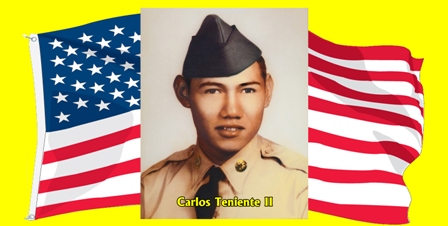

PROFILE OF A MUSEUM VOLUNTEER
CARLOS TENIENTE II
Carlos Teniente II was born
November 11, 1940 to farmers Basillio and Maria Teniente in San Antonio, Texas. Carlos was the youngest of 11 children and
was named after his older brother who was killed in Europe during World War
II. Brother Carlos is buried in the
military cemetery in Cambridge, England.
Carlos attended schools in the San Antonio School District,
graduating from high school in 1958. He immediately signed a three year enlistment in the U.S.
Army and was shipped to Fort Carson, Colorado for eight weeks basic training.
After basic he received orders to report to
Fort Leonard, Missouri for eight weeks of
combat engineering training. While there, a cadre of recruiters from the 101st
Airborne Division gave a presentation that encouraged the trainees to become
paratroopers. Carlos was so greatly impressed he immediately volunteered. The $55.00 dollars a month more in pay might
have had something to do with this decision!
Carlos was issued orders to report to Fort Campbell,
Kentucky, the home of the 101st Airborne Division for three
weeks. “Jump School” proved to be the
most intense training he ever received.
It required a lot of hard
discipline to convert a green trainee into a rough and ready airborne
trooper. Carlos had to endure the
constant browbeating from the gorilla instructors. He didn’t have a name; only a number duct
taped onto his steel pot helmet. Trainees were not allowed to just walk around;
they had to double time it every time they moved from one station to another
such as the Mocks Towers, and learn how to land with their body in the right
position, (That never happened!) as their normal landings were feet, ass, and
head. He began to wonder what ever made
him volunteer for this elite unit. Maybe
the money, the jump wings, and the special uniform that consisted of bloused
pants and jump boots??? At the end of
three weeks training it was “Jump Week” time.
They had to make five jumps “Hollywood Style” (which meant not carrying
any equipment) with only their main and reserve chute. The airplane used was a C-119; better known
as the Flying Boxcar, and they were trained to bail out at a height of 1200
feet. After graduation Carlos was
assigned to company B 502 Infantry Battle Group of the 101st
Airborne Division. He was now a full fledged
paratrooper. The 101st and 82nd
Airborne Divisions were trained to respond to any place in the world with a 24
hour time notice; therefore, they trained wearing full combat gear at all
times. No more Hollywood jumps; it was
now for real! They used C-119s, C-123s,
C-130s, and C124 airplanes. Carlos made
20 plus jumps without any major injuries.
Carlos was sent to train at a Radio Telephone Operator
School and was assigned to be the platoon’s radio man. In addition to all his combat gear, he was
required to jump with his radio. Carlos
used what is called a GP Bag, where all his gear was packed to be attached to
his body just below his parachute reserve.
The upside was that he was the first to jump, just behind the jump
master. When he was approximately at tree top level, he would release the bag,
which had a 20 foot lowering strap that would enable it to land before him. By
the time the company had landed and was assembled, he had unpacked his radio
gear and was in contact with the Company Commander.
He remained with the unit until his discharge on August 26,
1961.
Carlos and Gloria Lazalde were married on November 26, 1961and have two
daughters, Cynthia and Rebecca. In 1972 Carlos graduated from a four year
apprentice program as a sheet metal mechanic. The family moved to California
that same year and Carlos began working in a Civil Service position at Miramar
Naval Air Station in San Diego.
In 1974 Carlos applied and was selected for a position at the Naval Air Station in
Adak, Alaska
(the Aleutian Islands). He wo rked
there twenty years; retiring in Anchorage.
That same year, (1994) he couldn’t resist an offer to work for Alaska
Airlines. Ten years later Carlos retired
for a second time, and in 2004 the family relocated to Fresno, California to be
near their two grandchildren. In 2008,
Carlos read in the Fresno Bee that the Veterans Memorial Museum was looking for
veterans to volunteer as docents. Carlos
was interviewed by Director Art. Hill, and was pleased to have been
selected. He enjoys the history of times
gone by, and the camaraderie of his fellow docents.
|